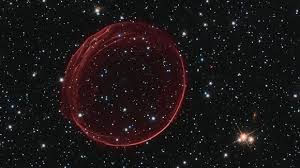TIME TRAVEL: FICTION OR REALITY (II)
- planck
- Aug 1
- 4 min read
In the first part we saw that, theoretically, a hypothetical superluminal tachyon would allow information to be sent to the past, which would create serious problems of causality. As is well known, relativity does not allow anything to move faster than c, which implies that special relativity prohibits time travel. However, there is a possibility of "circumventing" this principle: general relativity tells us that space-time itself can curve, compress, or expand, and there is no limit to the speed at which this happens; that is, space-time itself can expand faster than c . This happened, for example, during the period of cosmic inflation that gave rise to the Universe as we know it. Below we will see how we can take advantage of this to travel at greater speeds.
speed that c.
Warp Drive: Bending Space-Time
After the Big Bang the Universe expanded following the so-called Friedman metric:

where:

This expression simply tells us that space expands continuously with a factor a(t). Based on this metric, we can in principle "design" a metric that contracts spacetime in front of an object and expands spacetime behind it. The net result of this would be that the object would travel forward without speed restrictions since it is spacetime itself that is compressing and expanding. This is the principle on which the so-called "Warp-Drive" is based. Space
The space-time area where it compresses and expands would form a "bubble" containing the object we want to move. The Warp Drive would then work by producing the following metric:

where r(t) simply measures the distance at time t from the origin of the coordinates to the center of the bubble:

The above metric simply tells us that the center of the bubble moves along the z axis with a velocity v(t). The metric tensor would be:

and the function f(r(t)) would be any function that tends to 1 inside the bubble and to 0 outside it. For example:

One of the key features of Warp Drive is that time dilation is zero inside the bubble. We can easily see this: by replacing the location of the bubble's center (x,y,z) with (0,0,zeta) and considering that f(0)=1 and dx=dy=0, we obtain:

This means that the center of the bubble can be considered at rest even though the surrounding bubble+wall+space-time system is moving forward at enormous speeds.
The other key is to observe how the warp drive compresses space-time in front of the bubble and expands it behind it, producing a net forward displacement of the bubble. In general relativity, the expansion of space-time can be calculated by taking the main diagonal of the tensor that defines the extrinsic curvature, which in this case would be:

Since f equals 1 inside the bubble and 0 outside it, the only place where its derivative does not vanish is during the transition from 1 to 0, i.e. at the warp drive wall. The key is that at the forward wall z>zeta and therefore the derivative of f is negative , which means that fi is negative and therefore spacetime is contracting at the forward wall of the bubble . At the rear wall the opposite happens, it holds that z

Simulation of the Warp-Drive metric: Space-time contracts in front of the bubble (negative values) and expands behind it (positive values) while remaining unchanged within it.
Construction of the Warp Drive
The theory seems fairly straightforward, but can a warp drive actually be built? How could something like this be done in practice? To answer this question, we'll analyze the energy-momentum tensor associated with our warp drive. After some calculations, we obtain:

This means that we need matter with negative energy density to build our time machine! Although physical phenomena are known in very specific situations that can produce negative energy, the conditions to produce it are certainly quite difficult to achieve. But how much matter with negative energy are we talking about? Well, considering R=100 and taking the thickness of the bubble wall e<100v (in Planck units) we get that E<-6.2x10exp-70v which means that we need about 1.3x10exp63v Kg! This is no less than 10 orders of magnitude greater than the mass of the Universe. Is the dream of Warp Drive over? If we consider a 1 meter wall then the amount of negative energy needed would be "only": -5x10exp29v Kg This is approximately the mass of the Sun!
Quantum Effects in Warp Drive
So far, our description has been purely classical, without taking quantum phenomena into account, but as we know, the world is quantum on a fundamental scale. Warp Drive studies that take quantum phenomena into account indicate that the negative energy required for it to operate must be confined within the bubble wall to a size on the order of the Planck scale, Lp=10exp-35m. This imposes a thickness for the bubble that is practically impossible to achieve.
Another problem would be that, due to the geometry of the warp drive space-time, the bubble wall would behave like the event horizon of a black hole! And the center of the bubble would be filled with Hawking radiation coming from that horizon. For a wall thickness of the order of Lp, the temperature of the Hawking radiation would be on the order of 10exp32 degrees Kelvin!

Finally, another "minor problem" should be highlighted: at superluminal speeds, an event horizon would form inside the bubble, which would behave like a "white horizon": the energy density would grow without limit, producing a serious instability in space-time.
Conclusions
- Special relativity prohibits time travel since nothing can travel above c.
- General relativity allows for time travel since space-time itself can expand and contract without speed limits. Furthermore, objects such as wormholes could exist that would allow time travel under certain circumstances. However, in practice, the conditions for producing the necessary metric are nearly impossible to achieve.
- Semiclassical studies that take into account quantum mechanics and general relativity (under conditions of low gravitational fields) generally indicate that quantum phenomena would produce severe instabilities that would destroy our time machine.
- The quantum theory of gravity is yet to be discovered and probably holds the definitive answer to time travel.





Comments